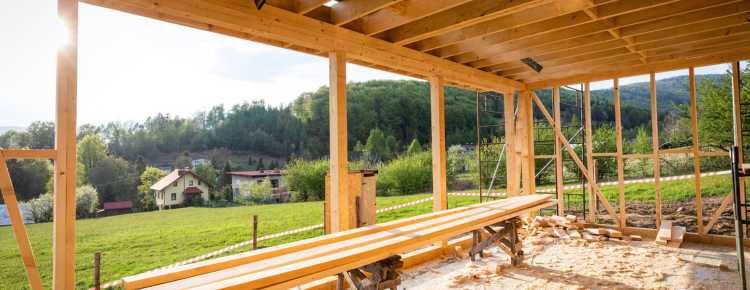
10 Ways To Minimize the Environmental Impact of Your Construction Site
According to the United Nations Environment Programme, the real estate industry is responsible for 40 percent of global carbon dioxide emissions, with 30 percent of that resulting from construction. But as a site manager or builder, you have the power to mitigate your project’s footprint by implementing these 10 eco-friendly construction practices.
Opt for Green Building Materials
Resource extraction, manufacturing processes and transportation of traditional construction materials like cement, glass and metal carry a significant environmental footprint. With sustainability becoming a bigger priority, some architects, engineers and builders are now using recycled, reclaimed or sustainably sourced materials as well as reclaimed wood, recycled concrete, or low-VOC paints. Not only can these solutions decrease a construction project's carbon footprint, but they also support the green building industry as a whole.
Prioritize Energy Efficiency
Adopting practices like energy-efficient lighting, HVAC systems, and waste reduction strategies can substantially reduce a project’s GHG output. Some construction projects are even integrating renewable sources such as solar panels or wind turbines to power the site. By embracing clean energy solutions, your team is showing respect for the planet while acting as an example for others.
Manage Water Wisely
Some of the most significant water waste and erosion takes place during site preparation and foundation work. To ease the strain on local water resources and reduce your team’s water consumption, consider installing water-efficient fixtures for site facilities. You can also establish a water management plan that uses rainwater harvesting systems like rain barrels or cisterns to collect water for various construction purposes, from irrigation to dust suppression. Silt fences and sediment basins can also act as erosion controls, preventing runoff and protecting nearby water bodies from pollution.
Reduce Waste and Recycle
Each year, the construction and demolition industry generates over 600 million tons of debris, but only 20 to 30 percent of this waste is recycled, with the rest ending up in landfills. To minimize your team’s ecological footprint, establish a sustainable waste management plan that includes recycling concrete, metal and other waste. Here, you can set up recycling stations instructing workers to separate metal scraps, concrete debris, and wood waste. You might also consider donating reusable materials to local charities or recycling centers to further minimize waste.
Use Low-Impact Construction Techniques
Modular construction, the building technique where a structure is 70 percent prefabricated before it reaches the construction site, can go a long way in reducing costs, time and impact of your project on the environment. This method minimizes energy and waste because offcuts are reused for future projects, instead of being discarded at the construction site. There’s also the option of fully prefabricating a structure off-site which helps reduce the project’s overall environmental impact.
Promote Biodiversity and Green Spaces
Integrating green spaces in your construction zone can be a win-win for both the environment and the local community. Green spaces improve air quality, enhance aesthetics, and provide a peaceful environment for workers and nearby residents. During the construction process, consider preserving existing trees and even planting more to create a healthier ecosystem. By promoting biodiversity, you are preserving natural habitats for wildlife and contributing to a more resilient and sustainable environment.
Monitor and Control Air Pollution
The dust, emissions, and particulates released into the air during a construction project can lead to air quality issues that impact workers and the surrounding community. To mitigate this, implement measures to control dust emissions, like water sprays, and limiting construction traffic during peak hours to reduce exhaust emissions. You can also use electric or hybrid equipment to reduce noise pollution and minimize carbon emissions, and air quality monitoring can help you stay on top of potential issues and take corrective actions quickly.
Encourage Sustainable Transportation
When it comes to environmental impact, how your construction team gets to and from the site can be as important as the work they do once they arrive. Encourage workers to use green modes of transport by offering incentives for workers to carpool, cycle, or use public transportation. You can also consider setting up dedicated parking spaces for electric or hybrid vehicles to encourage their adoption.
Collaborate with Local Communities
Connecting with local communities during the planning stages and throughout the course of a project can demonstrate your team’s respect for the environment and foster positive relationships. Whether they’re worried about noise, pollution or environmental impact, listen to locals’ concerns and involve them in the decision-making process. This approach can help create a sense of shared responsibility, leading to more sustainable and well-received projects. By considering community feedback, you can address potential issues proactively, create more resilient structures, and ensure your project aligns with the needs of the surrounding area.
Strive for LEED Certification
Another way to demonstrate your commitment to environmental stewardship while setting a positive example for the entire construction industry is to consider pursuing LEED certification.
According to a report by the U.S. Department of Energy, LEED-certified buildings have reported 34 percent lower CO2 emissions, 25 percent less energy use, and 11 percent lower water use compared to conventional buildings.
Implementing the above efforts can help protect the planet, while also reducing costs, enhancing community relations, and increasing market appeal for your projects. The key lies in making informed choices, collaborating with stakeholders, and embracing a long-term vision of sustainability. By continuing to prioritize eco-friendly practices, you are paving the way for a greener, more sustainable construction industry.
If you’re interested in connecting with green building companies or suppliers in your area, look no further than Intengine.com. The global directory of sustainable businesses features an array of smart search filters that let you search, find, filter and connect with sustainably minded organizations in just a few clicks.
Tags: construction, green building materials, energy efficiency, water management, modular construction, sustainable transportation, leed certification, construction industry
